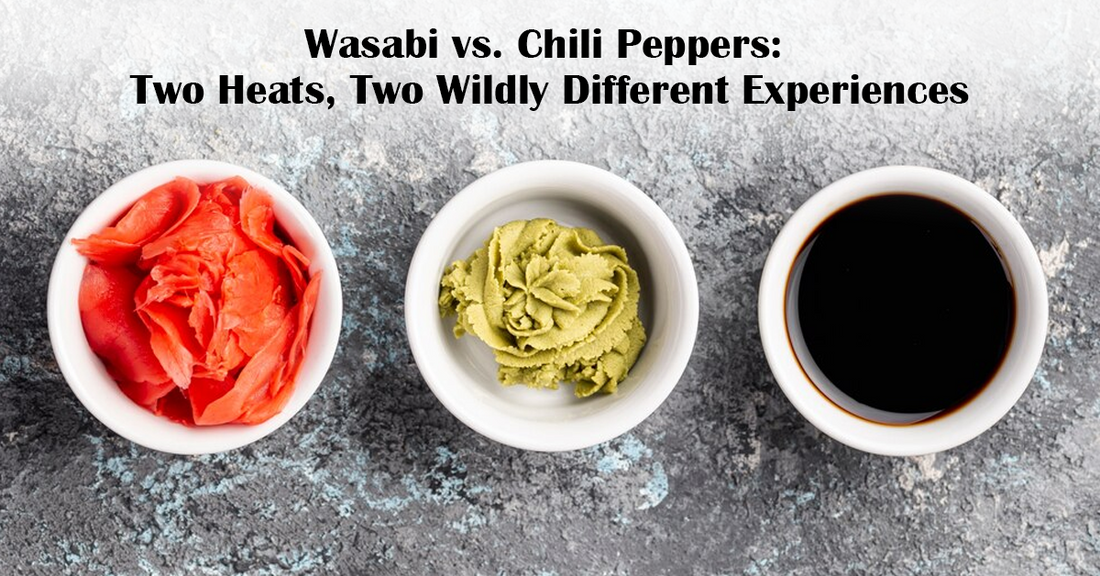Wasabi vs. Chili Peppers: Two Heats, Two Wildly Different Experiences

When you think of spicy foods, what comes to mind first—wasabi or chili peppers? While both bring the heat, the way they set your taste buds on fire is completely different. If you've ever taken a bite of real wasabi (not the fake stuff often served with sushi), you know it delivers a fast, sinus-clearing zing that vanishes just as quickly as it arrived. Chili peppers, on the other hand, leave you sweating with a slow burn that lingers.
So, what makes these two spice sources so different? Let’s dive into the fascinating world of Wasabia japonica and chili peppers, break down their chemistry, compare their heat levels, and explore how you can incorporate real wasabi into your meals.
Not All "Wasabi" Is Created Equal
Before we get into the heat showdown, here’s an eye-opener: most "wasabi" in the U.S. isn’t wasabi at all. The green paste served at most sushi restaurants is typically a mix of horseradish, mustard, and food coloring. Authentic wasabi comes from the Japanese horseradish plant, Wasabia japonica, which is notoriously difficult to grow. It thrives in cool, shady conditions with pristine water, making it a rare and expensive crop.
That’s why fake wasabi is so common—but trust us, once you taste the real thing, you’ll never go back! For those who are curious, there are wasabi plants for sale from specialty growers who cultivate the real deal under controlled conditions.
The Science Behind the Spice: Wasabi vs. Chili Peppers
Spiciness isn’t just a taste—it’s a chemical reaction. The key difference between wasabi and chili peppers lies in the compounds responsible for their heat and how they interact with your senses.
Wasabi’s Flash-Fire Heat
The fiery sensation of real wasabi comes from allyl isothiocyanate. This compound is released only when the rhizome is freshly grated, which is why wasabi should always be prepared fresh. Allyl isothiocyanate is water-soluble and evaporates quickly, creating a short-lived but powerful nasal-clearing sensation. Unlike chili peppers, wasabi’s heat doesn’t burn your tongue—it hits the sinuses and fades within seconds.
Chili Peppers’ Lingering Burn
The slow-burning heat of chili peppers is caused by capsaicin, an oil-based compound that binds to pain receptors in your mouth and throat. Unlike wasabi’s fleeting heat, capsaicin sticks around, creating a long-lasting burn that builds over time. Since capsaicin is not water-soluble, drinking water won’t help—hence why dairy is the go-to remedy for spicy food lovers.
In short? Wasabi hits fast and fades fast, while chili peppers deliver a slow, fiery punch that lingers.
Measuring the Heat: How Spicy Is Wasabi Compared to Chili Peppers?
Spice levels are often measured using the Scoville Scale, which rates heat intensity in Scoville Heat Units (SHU).
l Wasabi: While wasabi isn’t officially measured on the Scoville scale, its heat is estimated to be around 1,000–1,500 SHU. However, since it evaporates quickly, it never feels as intense as even a mild chili pepper.
l Chili Peppers: Their heat varies dramatically. Here’s how some common varieties stack up:
1. Jalapeño: 2,500–8,000 SHU
2. Serrano: 10,000–23,000 SHU
3. Habanero: 100,000–350,000 SHU
4. Carolina Reaper: Up to 2.2 million SHU
So, while wasabi provides a sharp, fleeting burn, chili peppers bring a slow, intense heat that can range from mild to mouth-melting.
How to Use Real Wasabi in Your Kitchen?
If you’re lucky enough to get your hands on fresh Wasabia japonica, here are some delicious ways to use it:
Classic Sushi Pairing
Grate fresh wasabi onto sushi or sashimi for a bold yet balanced heat that complements the delicate flavors of fish.
Wasabi with Steak or Grilled Meats
Mix fresh wasabi into soy sauce or serve it alongside grilled meats for a unique, aromatic kick.
Wasabi Guacamole
Add grated wasabi to guacamole for a spicy twist that elevates your favorite dip.
Wasabi Dressing
Blend fresh wasabi into a light vinaigrette for salads or drizzle it over roasted vegetables for extra zing.
Spicy Wasabi Noodles
Stir freshly grated wasabi into cold soba noodles with soy sauce and sesame oil for a refreshing, spicy dish.
All of these are fantastic ways to use wasabi products that go far beyond the sushi bar.
Where to Find Real Wasabi?
Because Wasabia japonica is so rare, it’s not something you’ll find in a regular grocery store. However, you can buy authentic wasabi products like fresh rhizomes, leaves, stems, and even flowers from trusted specialty retailers online.
Looking for the real thing? Explore a top Authentic Wasabi Products Supplier like [Real Wasabi] to get wasabi plants for sale and have fresh wasabi products delivered straight to your door.
Getting the Most Out of Your Wasabi: Proper Grating Matters
Unlike chili peppers, which you can simply chop or blend, wasabi must be grated correctly to activate its heat. Traditional Japanese chefs use a sharkskin grater (oroshigane) to create a fine, smooth paste. If you don’t have one, a ceramic or metal grater will also work—just be sure to use circular motions to break down the cell walls properly.
Once grated, wasabi’s heat peaks within 5–10 minutes, so always serve it fresh!
Two Spices, Two Totally Different Experiences
Both wasabi and chili peppers bring the heat, but in completely different ways. If you’re looking for a quick, nose-tingling rush, wasabi is your best bet. If you love a slow, fiery burn that lingers, chili peppers will never disappoint.
Either way, spicy food lovers can appreciate the science behind these unique flavors—and if you’ve never tried real wasabi before, now’s the perfect time to experience the difference.
Explore authentic wasabi products, learn more about the Japanese horseradish plant, or check out wasabi plants for sale from a trusted Authentic Wasabi Products Supplier today.
Sources
- Wasabi Chemistry & Sensory Science – McGee, H. On Food and Cooking: The Science and Lore of the Kitchen.
- Capsaicin and Heat Perception – Szallasi, A. Capsaicin and the TRPV1 Receptor: From Basic Science to Novel Therapeutics.
- Scoville Scale Measurements – Bosland, P. W., "Chile Pepper Heat Scoville Scale," New Mexico State University.
- Wasabi Cultivation & Authenticity – Kadowaki, M. "Wasabi japonica: Growing Conditions and Commercial Availability," Journal of Japanese Agriculture.
- Traditional Wasabi Preparation – Japanese Culinary Institute, "Techniques for Grating and Serving Wasabi."
